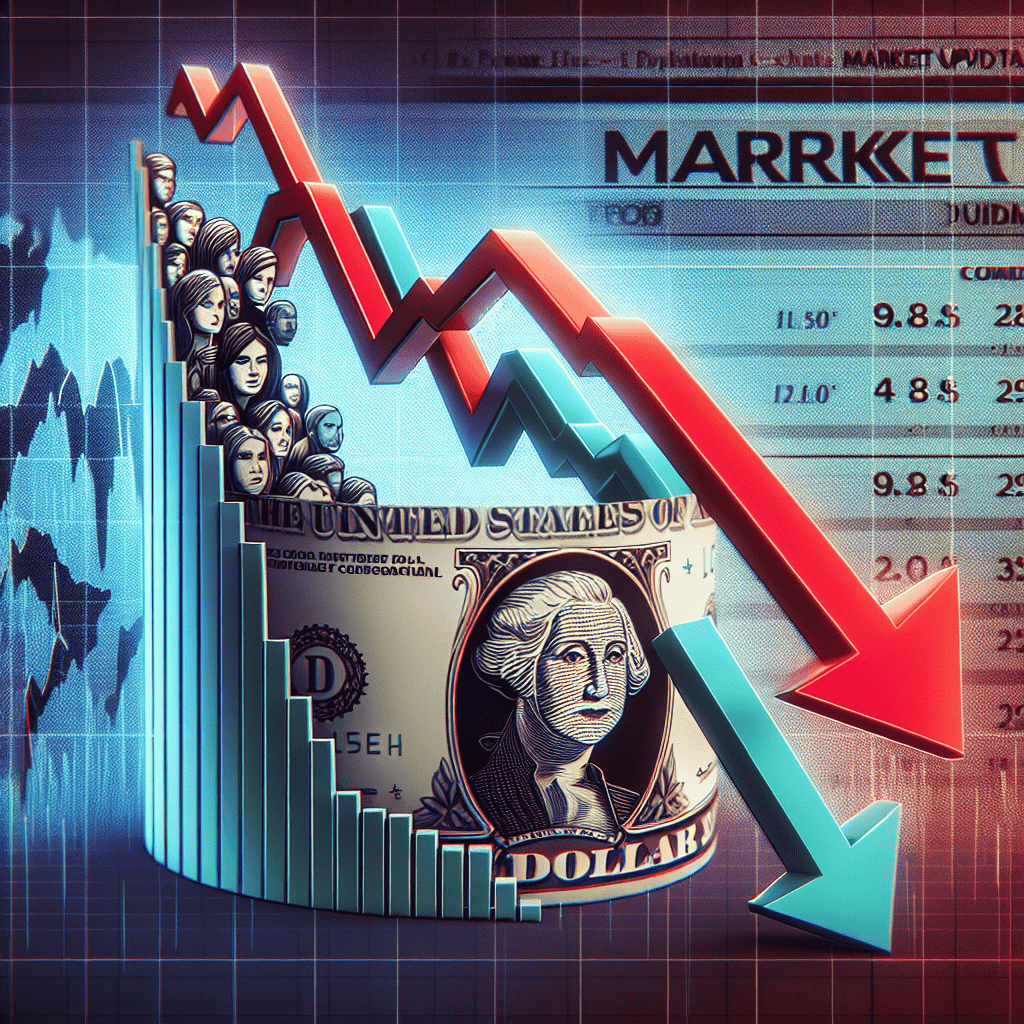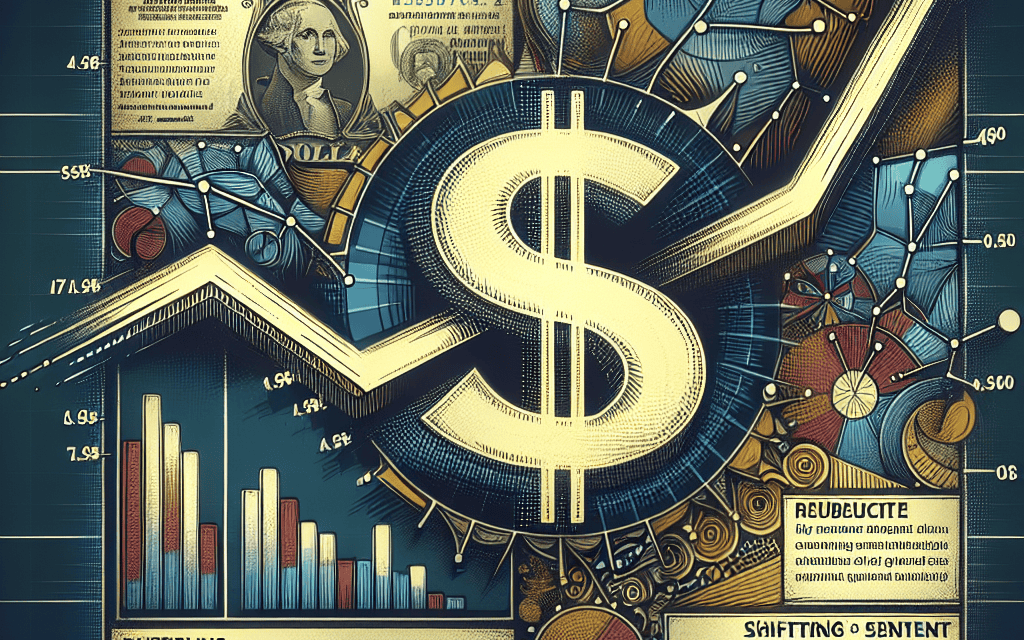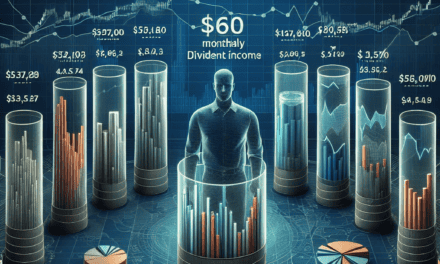“Market Sways as Dollar Dips: Harris Gains Momentum in US Polls”
Introduction
The dollar experienced a notable decline as shifting U.S. political dynamics began to favor Vice President Kamala Harris, according to recent polls. This market update highlights the currency’s response to evolving electoral sentiments, which have introduced new uncertainties into the financial landscape. Investors are closely monitoring these developments, as the potential for a Harris-led administration could signal changes in economic policy and international relations. The dollar’s depreciation reflects broader market apprehensions and recalibrations as stakeholders assess the implications of a possible shift in U.S. leadership.
Impact Of Dollar Decline On Global Markets
The recent decline of the US dollar has captured the attention of global markets, as shifting US polls increasingly favor Vice President Kamala Harris. This development has introduced a new layer of complexity to the already intricate web of international finance. As the dollar weakens, its impact reverberates across various sectors, influencing everything from commodity prices to emerging market economies. Understanding these dynamics is crucial for investors and policymakers alike, as they navigate the evolving landscape.
To begin with, the dollar’s decline can be attributed to a combination of political and economic factors. The growing support for Harris in the polls suggests potential shifts in US policy, which could lead to changes in fiscal and monetary strategies. Investors, anticipating these changes, may be adjusting their portfolios accordingly, leading to fluctuations in the currency’s value. Moreover, the Federal Reserve’s stance on interest rates and inflation continues to play a significant role in shaping the dollar’s trajectory. As the central bank grapples with balancing economic growth and inflationary pressures, its decisions will inevitably influence the currency’s strength.
The weakening dollar has a profound impact on global commodity markets. Commodities such as oil, gold, and agricultural products are typically priced in dollars, meaning that a decline in the currency’s value can make these goods cheaper for foreign buyers. Consequently, this can lead to increased demand and potentially higher prices, benefiting producers but posing challenges for consumers. For instance, oil-exporting countries may experience a boost in revenue, while nations reliant on imports could face rising costs, affecting their trade balances and economic stability.
In addition to commodities, emerging markets are particularly sensitive to fluctuations in the dollar. Many of these economies have significant amounts of debt denominated in US dollars. As the dollar weakens, the relative burden of this debt decreases, providing some relief to these countries. However, the situation is not without its risks. A volatile dollar can lead to capital flight, as investors seek safer havens, potentially destabilizing these economies. Furthermore, changes in US policy under a Harris administration could alter trade relationships and impact foreign investment flows, adding another layer of uncertainty for emerging markets.
The dollar’s decline also affects multinational corporations, particularly those with extensive operations abroad. A weaker dollar can enhance the competitiveness of US exports by making them cheaper for foreign buyers, potentially boosting sales and profits for American companies. Conversely, foreign firms operating in the US may find their products less competitive, impacting their market share and profitability. This dynamic underscores the interconnectedness of global markets and the importance of currency fluctuations in shaping business strategies.
In conclusion, the decline of the US dollar amid shifting polls favoring Kamala Harris has significant implications for global markets. From commodities to emerging economies and multinational corporations, the ripple effects are far-reaching. As investors and policymakers assess the potential outcomes of a Harris-led administration, they must remain vigilant in monitoring the evolving economic landscape. By understanding the intricate relationships between currency movements and global markets, stakeholders can better navigate the challenges and opportunities that lie ahead.
Harris’s Rising Popularity: Economic Implications
The recent shifts in the U.S. political landscape have captured the attention of both domestic and international markets, as Vice President Kamala Harris’s rising popularity in the polls has introduced a new dynamic to the economic outlook. As investors and analysts closely monitor these developments, the dollar has experienced a noticeable decline, reflecting the market’s response to the potential implications of a Harris-led administration. This shift in sentiment underscores the intricate relationship between political developments and economic indicators, highlighting the importance of understanding the broader context in which these changes occur.
To begin with, the dollar’s decline can be attributed to the uncertainty that often accompanies shifts in political power. As Vice President Harris gains traction in the polls, market participants are recalibrating their expectations regarding future economic policies. Historically, changes in administration can lead to significant shifts in fiscal and monetary policies, which in turn influence currency valuations. In this case, the prospect of a Harris presidency has prompted investors to reassess their positions, leading to a depreciation of the dollar as they anticipate potential changes in economic strategy.
Moreover, Vice President Harris’s policy priorities, which include a focus on social equity, climate change, and healthcare reform, are likely to have far-reaching economic implications. These areas of focus suggest a potential increase in government spending, which could lead to higher fiscal deficits. While increased spending may stimulate economic growth in the short term, it also raises concerns about inflationary pressures and the long-term sustainability of public finances. Consequently, the market’s reaction to Harris’s rising popularity reflects a complex interplay of optimism about potential economic stimulus and caution regarding fiscal discipline.
In addition to domestic considerations, the international dimension of currency markets cannot be overlooked. The dollar’s status as the world’s primary reserve currency means that shifts in U.S. political dynamics have global repercussions. As investors adjust their portfolios in response to changing expectations, the relative strength of other currencies, such as the euro and yen, may be affected. This interconnectedness underscores the importance of a nuanced understanding of both domestic and international factors when analyzing currency movements.
Furthermore, the Federal Reserve’s role in shaping monetary policy remains a critical factor in the dollar’s trajectory. As the central bank navigates the challenges of balancing economic growth with inflation control, its policy decisions will be closely scrutinized by market participants. A Harris administration may influence the Fed’s approach, particularly if her policies lead to changes in inflationary pressures or employment dynamics. Thus, the evolving political landscape adds another layer of complexity to the already intricate task of forecasting currency movements.
In conclusion, the dollar’s decline amid shifting U.S. polls favoring Vice President Kamala Harris highlights the intricate relationship between political developments and economic indicators. As markets respond to the potential implications of a Harris-led administration, investors are recalibrating their expectations regarding future economic policies. This dynamic underscores the importance of understanding the broader context in which these changes occur, as well as the interconnectedness of domestic and international factors. As the political landscape continues to evolve, market participants will remain vigilant, seeking to navigate the complexities of an ever-changing economic environment.
Currency Fluctuations: What Investors Need To Know
The recent fluctuations in the currency market have captured the attention of investors worldwide, particularly as the US dollar experiences a notable decline. This shift is largely attributed to the evolving political landscape in the United States, where recent polls indicate a growing favorability towards Vice President Kamala Harris. As investors seek to understand the implications of these developments, it is crucial to examine the interplay between political sentiment and currency valuation.
The US dollar, traditionally seen as a safe-haven currency, often reacts to political uncertainties and changes in leadership sentiment. In this context, the recent polls suggesting increased support for Harris have introduced a new dynamic into the market. Investors are now recalibrating their expectations, considering how a potential shift in political leadership might influence economic policies and, consequently, the strength of the dollar. This recalibration is not occurring in isolation; rather, it is part of a broader assessment of the US economic outlook.
Moreover, the dollar’s decline is not solely a reaction to domestic political developments. It is also influenced by global economic conditions and the relative performance of other major currencies. For instance, the euro and the yen have shown resilience, buoyed by their respective economic recoveries and monetary policies. As these currencies gain strength, the dollar’s relative value diminishes, further contributing to its decline. This interplay highlights the interconnected nature of global currency markets, where shifts in one region can have ripple effects across others.
In addition to political and global economic factors, investor sentiment plays a pivotal role in currency fluctuations. The perception of stability and predictability in US governance is crucial for maintaining investor confidence. As polls suggest a potential shift in leadership, investors are closely monitoring how this might impact fiscal and monetary policies. Any indication of significant policy changes could lead to increased volatility in the currency market, as investors adjust their portfolios to mitigate potential risks.
Furthermore, the Federal Reserve’s monetary policy decisions remain a key determinant of the dollar’s trajectory. The central bank’s stance on interest rates and inflation targets can either bolster or weaken the dollar, depending on how these policies align with market expectations. In the current environment, where political developments are adding a layer of complexity, the Fed’s actions are under even greater scrutiny. Investors are keenly aware that any deviation from anticipated policy paths could exacerbate the dollar’s decline or, conversely, provide a stabilizing effect.
As the situation unfolds, it is essential for investors to remain vigilant and informed. Understanding the multifaceted factors influencing currency fluctuations can aid in making strategic decisions. Diversification, hedging strategies, and staying abreast of both domestic and international developments are prudent measures in navigating this uncertain landscape. While the dollar’s decline amid shifting US polls favoring Harris presents challenges, it also offers opportunities for those adept at interpreting market signals.
In conclusion, the current decline of the US dollar is a reflection of complex interdependencies between political developments, global economic conditions, and investor sentiment. As the market continues to respond to these dynamics, investors must remain agile and informed, recognizing that currency fluctuations are an inherent aspect of the global financial system. By understanding the underlying factors at play, investors can better position themselves to navigate the evolving landscape and capitalize on emerging opportunities.
US Political Shifts And Their Effect On The Dollar

The recent fluctuations in the value of the US dollar have captured the attention of investors and analysts alike, as shifting political dynamics in the United States appear to be influencing market sentiment. In particular, the dollar’s decline has been closely associated with emerging polls that suggest a growing favorability towards Vice President Kamala Harris. This development has introduced a new layer of complexity to the already intricate relationship between political events and currency markets.
To understand the current situation, it is essential to consider the broader context of the US political landscape. As the nation approaches another election cycle, the political climate is becoming increasingly dynamic. Recent polls indicate a shift in public opinion, with Vice President Harris gaining traction among voters. This shift is significant because it suggests potential changes in future economic policies, which in turn can have profound implications for the financial markets.
The dollar, as a global reserve currency, is particularly sensitive to political developments in the United States. Investors often view the dollar as a safe haven during times of uncertainty, but they also react to potential changes in fiscal and monetary policies that could arise from shifts in political power. As Vice President Harris gains favor in the polls, market participants are beginning to speculate about the possible economic policies she might advocate if she were to assume a more prominent role in the administration.
One of the key factors contributing to the dollar’s decline is the anticipation of policy changes that could impact economic growth and inflation. For instance, if Harris were to prioritize policies that focus on social spending and infrastructure investment, it could lead to increased government spending. While such measures might stimulate economic growth in the short term, they could also raise concerns about inflationary pressures and fiscal deficits, which tend to weigh on the dollar’s value.
Moreover, the potential for changes in trade policies under a Harris-influenced administration could also affect the dollar. Investors are keenly aware that shifts in trade relations can have significant repercussions for the US economy and, by extension, the currency markets. Any indication of a move towards more protectionist policies or changes in international trade agreements could lead to increased volatility in the dollar’s exchange rate.
In addition to these economic considerations, the dollar’s decline is also influenced by broader geopolitical factors. As the US political landscape evolves, so too does its position on the global stage. Investors are closely monitoring how these changes might affect international relations and, consequently, the demand for the dollar as a reserve currency.
In conclusion, the recent decline of the US dollar amid shifting polls favoring Vice President Kamala Harris underscores the intricate interplay between political developments and currency markets. As investors navigate this evolving landscape, they must consider not only the potential economic policies that could emerge from these political shifts but also the broader geopolitical implications. While the future remains uncertain, one thing is clear: the relationship between US political dynamics and the dollar will continue to be a focal point for market participants in the coming months. As such, staying informed and adaptable will be crucial for those seeking to understand and respond to these complex and ever-changing market conditions.
Analyzing The Dollar’s Response To Political Trends
The recent fluctuations in the value of the U.S. dollar have captured the attention of investors and analysts alike, as shifting political dynamics appear to be influencing market behavior. In particular, the dollar’s decline has been closely associated with emerging trends in U.S. political polls, which now show a growing favorability towards Vice President Kamala Harris. This development has prompted a reevaluation of the potential economic policies that could be implemented under a Harris administration, thereby impacting investor sentiment and currency valuations.
To understand the dollar’s response to these political trends, it is essential to consider the broader context of the U.S. economic landscape. The dollar, as a global reserve currency, is highly sensitive to both domestic and international factors. Political stability and policy predictability are crucial elements that contribute to the currency’s strength. Consequently, any significant shifts in the political arena can lead to volatility in currency markets. As Vice President Harris gains traction in the polls, market participants are beginning to speculate on the possible implications for fiscal and monetary policy, which in turn affects the dollar’s performance.
Moreover, the anticipation of potential policy changes under a Harris-led administration is influencing market expectations. Investors are particularly focused on how such policies might impact economic growth, inflation, and interest rates. For instance, a Harris administration might prioritize social spending and infrastructure investment, which could lead to increased government borrowing. This scenario could exert downward pressure on the dollar, as higher fiscal deficits often lead to concerns about inflation and currency devaluation. Additionally, the prospect of regulatory changes in key sectors such as technology and healthcare could further contribute to market uncertainty, thereby affecting the dollar’s trajectory.
In addition to domestic considerations, the international dimension of the dollar’s decline cannot be overlooked. The global economic environment is characterized by interconnectedness, and shifts in U.S. political dynamics can have ripple effects across international markets. As the dollar weakens, other currencies, particularly those of emerging markets, may experience relative strength. This shift can alter trade balances and capital flows, further complicating the economic outlook. Furthermore, geopolitical considerations, such as trade relations and international cooperation, are likely to be influenced by the U.S. political landscape, adding another layer of complexity to currency market dynamics.
While the current political trends favoring Vice President Harris are a significant factor in the dollar’s recent decline, it is important to recognize that currency markets are inherently volatile and influenced by a multitude of factors. Economic indicators, central bank policies, and global events all play a role in shaping currency valuations. Therefore, while political developments are a key consideration, they are part of a broader tapestry of influences that determine the dollar’s performance.
In conclusion, the dollar’s decline amid shifting U.S. polls favoring Kamala Harris underscores the intricate relationship between political trends and currency markets. As investors navigate this evolving landscape, they must remain attuned to the potential policy implications of a Harris administration and their impact on economic fundamentals. By understanding the interplay between political dynamics and market behavior, stakeholders can better anticipate and respond to the challenges and opportunities that lie ahead.
Market Strategies Amid Dollar Volatility
The recent fluctuations in the value of the US dollar have captured the attention of market analysts and investors alike, as shifting political dynamics in the United States begin to influence economic forecasts. The dollar’s decline has been notably linked to emerging polls that suggest a growing favorability for Vice President Kamala Harris in the upcoming presidential race. This political development has introduced a new layer of complexity to market strategies, as investors seek to navigate the potential implications for economic policy and international trade.
In recent weeks, the dollar has experienced a downward trend, a movement that can be attributed to a combination of domestic political uncertainty and broader global economic factors. The increasing favorability of Vice President Harris in the polls has sparked discussions about potential shifts in economic policy, should she ascend to the presidency. Investors are particularly attentive to her stances on issues such as taxation, regulation, and international trade agreements, all of which could have significant ramifications for the US economy and, by extension, the value of the dollar.
Moreover, the dollar’s decline is not occurring in isolation. It is part of a broader pattern of currency volatility that has been exacerbated by ongoing geopolitical tensions and fluctuating economic indicators. As the Federal Reserve continues to navigate the delicate balance between controlling inflation and supporting economic growth, any perceived changes in political leadership could influence its monetary policy decisions. Consequently, market participants are closely monitoring the evolving political landscape, as it may offer clues about future fiscal and monetary policies.
In light of these developments, market strategies are being recalibrated to account for the potential impacts of a Harris presidency. Investors are increasingly considering hedging strategies to mitigate risks associated with currency fluctuations. Diversification across asset classes and geographic regions is becoming a more prominent approach, as it allows investors to spread risk and capitalize on opportunities in markets less affected by US political dynamics. Additionally, some investors are turning to safe-haven assets, such as gold and government bonds, to protect their portfolios against potential volatility.
Furthermore, the international response to the dollar’s decline is also shaping market strategies. As the dollar weakens, other currencies, particularly those of emerging markets, may experience relative strength. This shift presents both challenges and opportunities for investors. On one hand, a stronger local currency can benefit emerging market economies by reducing the cost of imports and easing inflationary pressures. On the other hand, it can also pose challenges for exporters who rely on competitive pricing in global markets.
In conclusion, the dollar’s recent decline amid shifting US polls favoring Vice President Harris underscores the intricate relationship between political developments and market dynamics. As investors navigate this period of uncertainty, they are employing a range of strategies to manage risk and capitalize on potential opportunities. By closely monitoring political trends and their potential economic implications, market participants aim to position themselves advantageously in an ever-evolving landscape. As the situation continues to unfold, adaptability and informed decision-making will remain crucial components of successful market strategies.
Future Projections: Dollar Trends And Political Changes
The recent fluctuations in the value of the US dollar have captured the attention of investors and analysts alike, as shifting political dynamics in the United States begin to influence market trends. With the latest polls indicating a growing favorability towards Vice President Kamala Harris, the currency markets are responding with a notable decline in the dollar’s strength. This development underscores the intricate relationship between political sentiment and economic indicators, highlighting the need for a nuanced understanding of how these factors interplay.
As the political landscape evolves, market participants are keenly aware of the potential implications for economic policy and international relations. The prospect of a Harris-led administration brings with it a set of expectations regarding fiscal and monetary policies, which could diverge from the current trajectory. Investors are particularly attuned to the possibility of increased government spending and regulatory changes, which may impact inflation rates and, consequently, the value of the dollar. In this context, the dollar’s recent decline can be seen as a reflection of market anticipation and uncertainty surrounding future policy directions.
Moreover, the global economic environment adds another layer of complexity to the dollar’s trajectory. As other major economies navigate their own recovery paths post-pandemic, the relative strength of the US dollar is influenced by comparative growth rates and interest rate differentials. The Federal Reserve’s monetary policy decisions, in particular, play a crucial role in shaping these dynamics. Should a Harris administration prioritize policies that lead to a more accommodative monetary stance, it could further pressure the dollar, especially if other central banks adopt a more hawkish approach.
In addition to domestic policy considerations, international relations are also a significant factor in the dollar’s performance. A potential shift in US foreign policy under Harris could alter trade relationships and geopolitical alliances, thereby affecting investor confidence and currency valuations. The market’s response to these potential changes is indicative of the broader sentiment that political leadership can have far-reaching effects on economic stability and growth prospects.
While the current decline in the dollar may raise concerns among some investors, it is essential to recognize that currency markets are inherently volatile and subject to a multitude of influences. The interplay between political developments and economic indicators is complex, and short-term fluctuations do not necessarily predict long-term trends. However, the current situation does highlight the importance of closely monitoring political developments and their potential impact on economic policy.
Looking ahead, market participants will continue to assess the evolving political landscape and its implications for the dollar. As the US approaches future elections, the interplay between political sentiment and economic indicators will likely intensify, making it crucial for investors to remain vigilant and adaptable. By understanding the potential ramifications of a Harris-led administration on fiscal and monetary policies, as well as international relations, investors can better navigate the uncertainties that lie ahead.
In conclusion, the recent decline in the US dollar amid shifting polls favoring Kamala Harris serves as a reminder of the intricate connections between politics and economics. As market participants grapple with the potential implications of these changes, the need for a comprehensive understanding of both domestic and international factors becomes increasingly apparent. By staying informed and adaptable, investors can better position themselves to respond to the evolving landscape and its impact on the dollar’s future trajectory.
Q&A
1. **What is causing the dollar to decline?**
The dollar is declining due to shifting US polls that are increasingly favoring Kamala Harris, leading to market uncertainty.
2. **How are the shifting polls affecting the market?**
The shifting polls are creating uncertainty in the market, causing investors to reassess their positions and leading to a decline in the dollar.
3. **What impact does a declining dollar have on the economy?**
A declining dollar can lead to increased export competitiveness but may also result in higher import costs and inflationary pressures.
4. **How are investors reacting to the changing political landscape?**
Investors are reacting by adjusting their portfolios, seeking safer assets, and hedging against potential volatility.
5. **What sectors are most affected by the dollar’s decline?**
Sectors such as technology and consumer goods, which rely heavily on imports, may be most affected due to increased costs.
6. **Are there any benefits to a weaker dollar?**
A weaker dollar can benefit US exporters by making their goods more competitive abroad, potentially boosting sales and profits.
7. **What are analysts predicting for the dollar’s future?**
Analysts are predicting continued volatility for the dollar, with potential further declines if political uncertainty persists.
Conclusion
The recent decline in the US dollar can be attributed to shifting political dynamics, as polls increasingly favor Vice President Kamala Harris. This political shift introduces uncertainty regarding future economic policies, prompting investors to reassess their positions. As a result, the dollar’s value has weakened against other major currencies. Market participants are closely monitoring these developments, as the potential for policy changes under a Harris administration could impact fiscal and monetary strategies, influencing the dollar’s trajectory in the global market.





